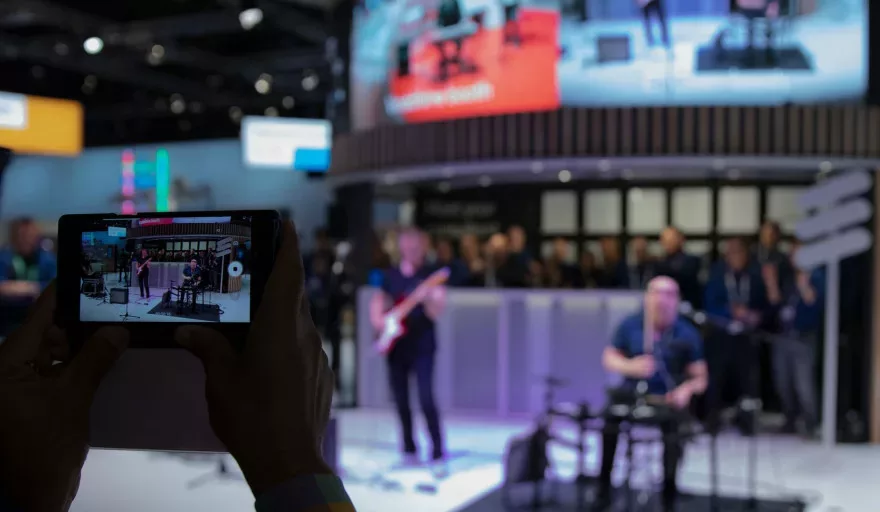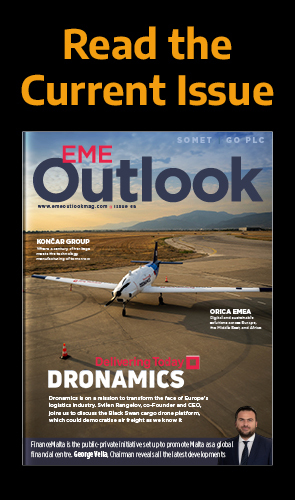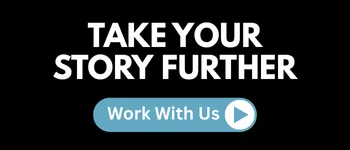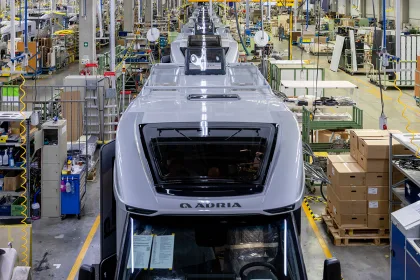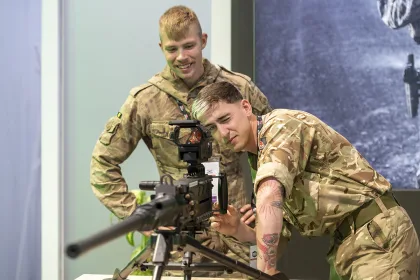At MWC, EME Outlook catches up with Håkan Andersson, the Head of Technology Strategy at the company Ericsson.
Abba’s single ‘Does Your Mother Know’ has remained timeless since its release in 1979.
Celebrating a landmark 40th anniversary next month, the song heavily featured in box office hits Johnny English in 2003 and Mamma Mia! in 2008, even being performed by UK rapper Dizzee Rascal during a recent tour.
However, despite having established itself as a staple of the pop genre, a booming live performance of the song was not what we were expecting to hear as we entered Ericsson’s Mobile World Congress booth.
Paying tribute to its home nation’s favourite band, the Swedish telecommunications giant put on a collaborative spectacle with Vodafone, showcasing 5G’s ever growing capabilities by demonstrating how a live band can now play together when not together.
“The idea, from Ericsson’s side at least, came from two guys at the Ericsson Research team,” explains Håkan Andersson, Head of Technology Strategy at the company. “Exploring the seemingly endless potential of 5G and low latency technology, they put forward the idea that then worked its way through an internal incubator, and it’s now become a reality here at Mobile World Congress.”
One of the largest booths at MWC 2019, Ericsson’s showcasing portfolio offered a true glimpse into the future.
From allowing attendees to remotely drive an all-electric autonomous truck in Gothenburg in real-time to providing attendees with access to its new Batman AR/VR experience, a sweep of the firm’s stands reinstated that this is a company pioneering next generation technologies, shaping the future of global connectivity.
AHEAD OF THE GAME
“Myself? I’ve been responsible for both the strategies and investment decisions for the development of our LTE and 5G technologies,” explains Andersson as we sat down for a chat behind the scenes. “From very early research activities to engagement with customers and the European Union, it’s been a real journey.”
Having joined Ericsson back in 1990, Andersson has worked across various internal divisions, starting out at Ericsson Research before moving into product development, portfolio management and now technology strategy.
“With such wide flexibility in opportunity, I’ve never had the desire to move on,” he explains. “The company offers personal diversification from within, the chance to travel extensively, and it’s a business where the culture is defined by innovation.”
Having accumulated broad oversight of Ericsson during the past three decades, Andersson is quick to emphasise that the firm’s research arm has been key to its ongoing success. A unit constituting 700 of the firm’s best and brightest, this division provides the platform from which its overriding strategies can thrive.
“Ericsson Research effectively makes it possible for us to navigate the technology landscape by piecing together calculated long term forecasts,” Andersson affirms. “Historically this is something Ericsson has been extremely effective at. We don’t push technologies aimlessly – everything we pursue is built on the foundations of measured research, an approach that provides us with substantial credibility.”
One such example can be found in the firm’s introduction of the 5G PlayStations, products that the company has been producing since 2015, according to Andersson.
“We’ve now actually shipped three million such consoles that have been 5G-readied,” he reveals. “Our research allowed us to have a good early understanding of how 5G should be used and we made early adjustments to ensure that this was aligned with the existing LTE interface.
“As a result, we could actually start developing these PlayStations in order to support 5G, even before the technology itself was rolled out. This futureproofing really provides us with an edge.”
INSPIRING COLLECTIVE EXCELLENCE
Collaboration, alongside research, is another area that the Head of Technology Strategy is quick to highlight as a hugely important aspect of Ericsson’s grasp on innovation.
Readily involved in transformative industry bodies like the 5G Automotive Association and aiding Stockholm’s smart city efforts, Ericsson has established itself as a fundamental player within the global technological ecosystem.
“We’re not betting on any one thing,” explains Andersson. “We have extremely smart guys working at Ericsson Research, however, we also recognise that cooperative agreements an alternative yet fantastic source of new ideas.”
The company’s extensive 5G collaboration with the Fraunhofer Institute for Production technology and MTU Aero Engines showcases this strategy effectively. Leveraging the different expertise of the three organisations, the trio researched and developed new methods for improving process control and discovering manufacturing failures during the production of bladed disks in real-time.
The result? MTU Aero Engines is now able to use 5G and sensory technology to reduce the time for the process design phase by 75 percent, create annual savings of up to €27 million for a single factory.
Moreover, the firm often benefits from similar synergies between itself and its customers, this revealed in its work with leading Australian telecommunications giant Telstra in expanding its Narrow Band IoT range.
“This was an exciting challenge,” Andersson states, “looking at how to get good coverage in a country like Australia with its huge landmass and geographically divided populations. What we’ve done is extend the range of many existing cell towers to 100 kilometres, 60 kilometres more than 3GPP standards-based limits.
“A big focus of our 5G research from the beginning was focusing on bolstering antenna capabilities and the Telstra project is a real showcase of this evolution. In certain instances, we’ve actually driven 10-fold capacity increases in Telstra’s networks in a cost-effective manner, something we’re really proud of.”
VIRTUALISATION AND REALISATION
The Telstra and Fraunhofer Institution collaborations are two of examples for the firm’s wide remit, a third being its Technology for Good @ Roraima project.
First conceived in 2017, the programme was borne in the wake of the Brazilian government’s requests for a new technological solution to provide an enhanced response to the Venezuelan migration situation that would benefit both the migrants themselves and the local Roraima population.
In response, Ericsson founded a new partnership with Vivo (Telefónica Brazil) in order to both bring 4G connectivity to the region and build a digital lab in Boa Vista, the capital of Roraima, that would provide digital inclusion for many of the Venezuelan migrants.
A prime example of how technology can be used not only to the benefit of industrial and commercial spheres but equally humanitarian ventures, the Technology for Good project was nominated as Best Mobile Innovation supporting Emergency or Humanitarian Situations – one of five Global Mobile Award nominations that Ericsson received this year, one of which they won.
From automated network operations, cloud infrastructure and managed network solutions to intelligent optimisation, agile application management and data driven operations, Ericsson will undoubtedly remain a key facilitator of digital transformation for decades to come.
“When we talk about 5G, we’re talking about the virtualisation of core networks,” Andersson states, summarising his outlook on the technology’s growing capabilities. “Slicing had allowed workloads to be distributed in different places, while software definition has allowed us to repurpose the same infrastructure for different things.”
“Whether this is a public safety network, a network for industry use cases or one for mobile broadband, we are now able to run these on a common infrastructure.”
He concludes: “Taking these transformative framework capabilities and coupling them with artificial intelligence, cloud capabilities and new software-led developments, we will see networks becoming increasingly elevated for all.”



